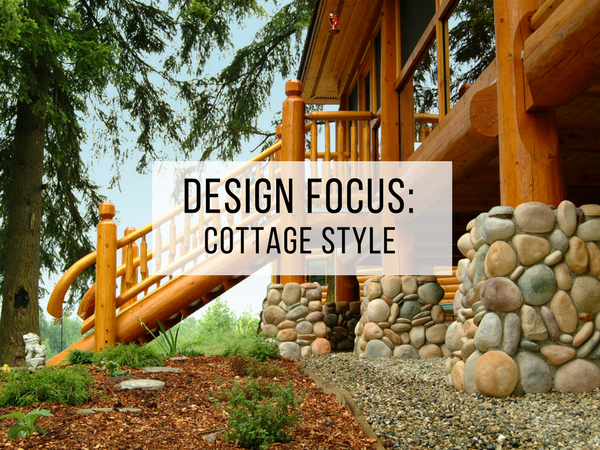
Cottage style is growing in popularity and that could be attributed to people yearning for simpler living. It is also considered to be synonymous with coziness, connoting smallness, but not smallness in a cramped way – a comfortable and together way. Creating a cottage feel is creating a cozy space that rises up and welcomes you, invites you to stay awhile and makes you feel happy.
The word “cottage” comes from medieval England between the 5th and 6th centuries and was affiliated with proletariat living. This was reserved for peasants or ‘cotters’. With no power over their dwellings, the cottages were usually extremely modest with a small ground floor living space and lower story bedrooms which fit under a pitched roof. When the style emerged in North America, it was a housing solution for slaves. Not subscribing to any connotations, Canadian cottages are more free flow than in other territories.
The style evolved significantly over the years. The more familiar style of rustic cottage architecture, typically made with heavy stones or wood, emerged in the 18th century. Instead of being occupied by cotters or serfs, modern cottages are now owned by wealthier families as vacation properties, often located near a lake or in the mountains.
COTTAGE STYLE: CHARACTERISTICS
Cottage homes can be identified by their smaller square footage and unique design. The design may include small balconies, bay windows or gable roofs. Wood is often used as an exterior covering, giving the home a more natural appearance. Cottage style homes encompass a broad range of designs and feature unique architectural choices reminiscent of cabin or lakefront properties.
This design favours an eclectic taste. Unlike more edited decorating styles, cottage style is more pliable. You can mix old and new; rare and inexpensive; and simple and ornate pieces. Stone is another important element in the cottage style. These homes feature natural cladding materials such as stone or brick for texture. A prominent roofline and picturesque dormers give the homes height and visual presence. Decorative touches such as vertical exterior paneling, a stone facade or strong geometric shapes set them apart from more contemporary styles. Popular in rural areas, the cottage style has now made its way to urban residential and semi-residential areas.
Cottage style house plans are characterized by their individuality. Modern cottage floor plans are adapted for today’s lifestyles, with cozy family gathering spaces and an unpretentious beauty. This design was practically synonymous with shabby chic. A vintage charm underlines this style. Faded prints, light colours and gently distressed pieces is a mainstay cottage decor. To acquire the quaint look, more rustic furnishings that can take a few hard knocks is recommended. Traditional cottage homes stay true to the abundance of wood from the floors to ceilings. Wood (stained, painted, pickled, stencilled or simply left natural) is queen, often accented with brick or stone. Cottage kitchens generally utilize shelves to stacks plates and bowls, canisters of dry goods and baskets of edibles. Modern type kitchens still use shelves but they look as much decorative as they are utilitarian.
Although a general quaint look is signature of the style, the right accessories will help create looks to cater to particular personalities. Classic cottage furniture and decor emphasizes clean lines and classic shapes that stand the test of time. But even with a more tailored approach, there is still a welcoming, comfortable feeling to the furniture style, colour, and fabric choices. Mix and match old and new, found and bought for a eclectic, casual style. Cultivate a lived-in relaxing vibe with weathered finishes and rustic touches with a hint of colour. Soften the feel for a romantic feel with soft pastels and neutral palettes. Experimenting with the style brings the dreamy design to life.
CANADIAN COTTAGES
Canada is home to an impressive variety of architectural styles, representing the diverse and unique areas of the country. Its breathtaking wintry areas in the north can welcome a huge array of cabins and cottages, perfect for use as a vacation getaway or a year-round home in the right location. Warm and inviting, the cottages are havens for families.
These types of Canadian houses include more rustic exteriors that resemble iconic log cabins by utilizing natural wood materials, as well as more current stylings that take the concept of a cozy cottage and incorporate more clean lines and modern aesthetics.
YOUR COTTAGE HOME
Depending on the age of your cottage or how long you’ve owned it, you might feel it’s time to give it a facelift. If you are adding a few elements to your existing home or on the market for a cottage style home, a great place to start is by recreating the cottage style. Remember, the look is more important than particular shapes or lines. Get creative with colours and finishes with compliments of manufactured stones for a warm, nature inspired effect.
Stacked stone, like Cultured Stone® Country Ledgestone, or ThinCut™ Machine Cut, Weathered Fieldstone, offers a simple way to upgrade the look of your property without it looking out of place in more contemporary environs. The classic look achieved by installing tight-fit stone means your cottage will stand out, but as a modern throwback to a simpler time, and without degrading the surrounding area.
Manufactured stone enhances any architectural design. The stones are lightweight and easy to install which cuts costs significantly. It will make any cottage space cozy.